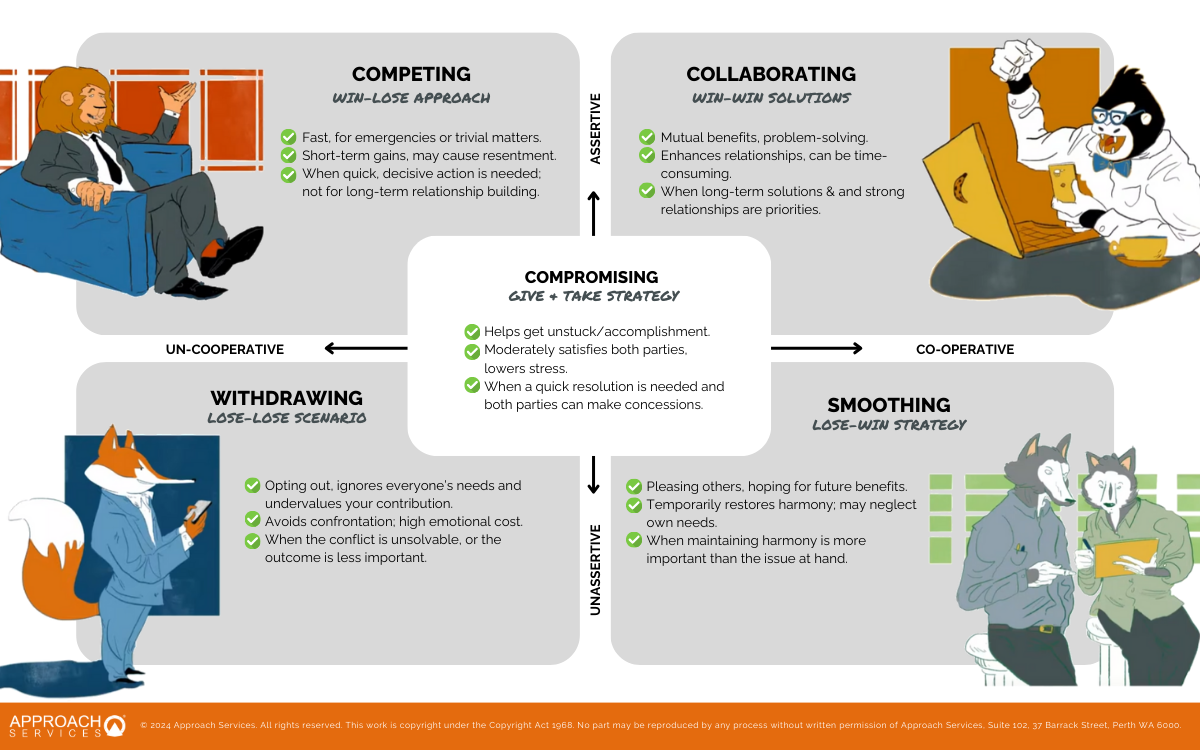📖 Reading time: 5 mins
Conflict in the workplace is often seen as a negative and destructive force. However, what if we shift our perspective and see it as an opportunity for growth, creativity, and innovation? What if our team members contributed their "recipes" for resolving conflicts, including the ingredients (steps) and the method (approach) into a fun and helpful "Conflict Cookbook" that can be referred to when sticky situations arise?
In this blog, we will explore how leaders can harness conflicts to transform their teams and organisations. By understanding the role of conflicts in a constantly changing workplace, utilising effective conflict resolution techniques, and managing emotional responses, leaders can turn conflicts into valuable learning experiences for themselves and their teams. Let us dive in and discover how to transform workplace conflicts into creative solutions.
Understanding the role of conflicts in a constantly changing workplace
In today's fast-paced and ever-evolving work environments, conflicts are bound to arise. However, they should not be seen as solely negative or disruptive forces. Conflicts and resistance can serve as indicators of stagnation, progress and transformation. For example on Thankful Thursdays, our team shares something we appreciate about a conflict we had in the past. This practice not only helps in resolving lingering resentments but also promotes a culture of gratitude and understanding.
Let's say our team disagrees about the direction of a project. This is a task conflict. This task conflict indicates that there is not enough clarity or alignment in the team's overall goals and progressing the project without resolution can lead to serious delays. By addressing this conflict early, e.g. at the discomfort or incident level, leaders can help their teams identify and resolve underlying issues and improve collaboration and project delivery.
If conflicts are not addressed early on, they can escalate and lead to misunderstandings, tension, and even crises within the team. This can create a toxic work environment where individuals may feel unsupported or unheard, leading to decreased motivation and negativity. Looking at the symptoms we often observe higher turnover and absenteeism. In situations like these a month-long Drama-Free December challenge can work a treat. Implement daily or weekly challenges, such as "No Complaints Day," "Feedback Friday," or "Mediation Monday," where team members focus on specific aspects of constructive conflict resolution. Reward the team with a celebration if they meet their goals. However, the first step to leveraging conflicts for growth is to put your conflict solver goggles on and spot the early warning signs.
Conflict Resolution in Change Turning Conflicts into Solutions
Want to become the office superhero? Zap! Pow! Bang! Say goodbye to awkward silences and hello to high-fives! Our conflict resolution course turns everyday employees into fearless facilitators of peace.
Staying Hard on the Issue, Soft on the Person: addressing conflicts effectively
One of the key skills in handling conflicts is to stay hard on the issue at hand while remaining soft on the person involved. This means focusing on the different perspectives on tasks, processes, or status, rather than getting caught up in personal attacks or ego battles. To effectively address conflicts, you must clarify the type of conflict you are dealing with.
The most common types of conflicts are:
By identifying the type of conflict and understanding its root cause, leaders can choose the most appropriate approach to address it. They can foster open communication, encourage active listening, and facilitate a mutual understanding of both sides' perspectives. Maybe try a role-swap scenario by reversing the usual roles in conflicts (e.g., the team leader might have to play the team member and vice versa). This exercise, done with humour and care, can provide insights into different perspectives and foster empathy. Applied conflict resolution allows individuals to feel heard and respected, paving the way for finding creative solutions together.
As a manager, navigating the choppy waters of workplace conflict was always challenging, especially during periods of change. However, the Conflict Resolution Training provided by Approach Services has been a game-changer for our team. The online course wasn’t just informative—it was a roadmap to genuine, constructive change management.
-C. Evans, HR Manager
Mind over emotions: Managing instinctive and emotional responses during conflicts
One of the keys to effectively handling conflicts is self-awareness. By understanding our conflict solver style, we can choose the most appropriate approach for each situation. Some people may be more comfortable with confrontation, while others may prefer a more collaborative problem-solving approach. To get more comfortable with different conflict solver styles you could design a roulette wheel with the 5 conflict resolution approaches listed on it. When a conflict arises, spin the wheel to decide on the method to play through for resolution. This adds an element of unpredictability and fun to practising your skills with a mentor. (Warning: Do not try this in real life). In real workplace conflicts, you must consider the other party's conflict resolution style and choose an approach that is likely to be effective for the situation. Being self-aware and adaptable in our conflict resolution strategies, helps us find mutually beneficial solutions and improve relationships within the workplace. Unfortunately, emotions can often run high during conflicts and hinder our ability to handle them effectively.
As leaders, it is essential to recognise our core belief cycle and the emotions that arise during conflicts and manage them appropriately. It is natural for people to feel angry, defensive or frustrated when facing a conflict. However, reacting impulsively based on these emotions may escalate the situation and prolong the conflict.
Here are some practical tips for managing emotions during conflicts:
Leaders who manage their emotions well and stay calm can create a safe space for open communication and collaborative problem-solving. You may introduce Peace Pizza - a casual team lunch, where team members are encouraged to discuss and resolve smaller issues over slices. This informal setting can make the process of addressing conflicts less intimidating and more engaging.
Handling conflicts calmly and constructively
Unresolved workplace conflicts often cause tension and strain on relationships. This in turn is bad for people's physical and mental wellbeing. As a leader, it is crucial to know how to handle these conflicts effectively. The eight-step de-escalation process offers a helpful framework for managing conflicts effectively.

For example, in a meeting where two team members, John and Sarah, have different opinions on how to approach a project. As their leader, you can apply the eight-step de-escalation process. Respond calmly and ask others to leave the room. Try to understand the situation and where John and Sarah disagree. You classify the incident as a process disagreement and set a goal to find a solution that satisfies both John and Sarah. By facilitating a brainstorming session, you encourage open communication and collaboration, leading to a joint plan that benefits everyone.
With the techniques and tools in this blog, leaders can turn conflicts into opportunities for growth and collaboration. Instead of avoiding or fearing workplace conflicts, embrace them as chances for learning, innovation, and positive change. With the right mindset and approach conflicts can be transformed into creative solutions that drive progress within organisations.

Eva is one of the masterminds behind Approach Services' blog and The 6 Cents of Change. She is an innovator, trainer and change manager. Her work has been published in the Schmalenbach Journal of Business Research. In her spare time, she enjoys camping with her two little boys and permaculture gardening.
Subscribe to our monthly newsletter The 6 Cents of Change and follow us on LinkedIn to learn more!





